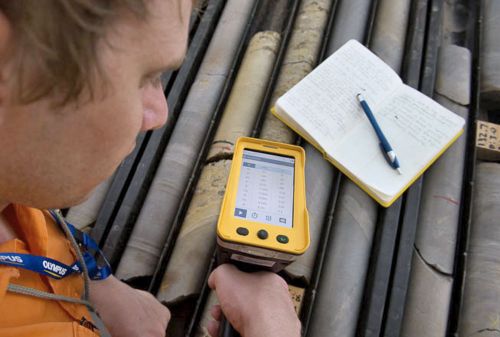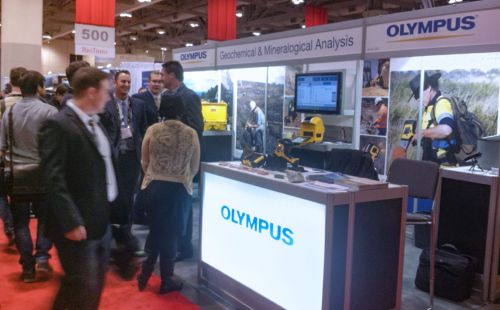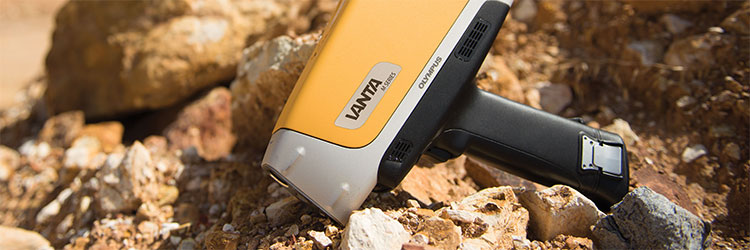Portable X-ray fluorescence (pXRF), also called handheld XRF, can add significant value when used correctly on geoscientific projects, but can also mislead users without adequate training in the absence of appropriate procedures. This guide to pXRF best practices is based on the learnings of our team and our customers and outlines important considerations for anyone working with pXRF in geoscientific applications. This guide is not intended to be exhaustive but presents best practices to help mitigate some commonly experienced challenges.
We promote the benefits of portable XRF all the time — fast, portable, nondestructive, and quantitative. Portable XRF has helped companies save money on their projects, however, it’s important to understand the limitations of pXRF technology so that users can develop appropriate methods and workflows to overcome them.
 |
| Testing core: one of the "most challenging" applications of pXRF. Are users wasting their time using pXRF to test core? Check out this presentation by Dennis Arne of CSA Global on this and other topics. |
Portable XRF Limitations
Some of the well-known limitations of pXRF include:
- The limits of detection are not as low as lab results and not all elements are possible.
- Method certification — currently, it’s not possible to use pXRF-generated data in resource estimation calculations in accordance with JORC, NI 43-101, and other statutory reporting codes, but it can be used effectively for reporting exploration results, grade control, and many other uses.
- Portable XRF produces elemental data, not compounds or oxide species. However, these data can be converted to oxides if the phase is well understood (e.g. iron (Fe) to Fe203).
- XRF analyzers produce X-rays, so radiation safety protocols should be followed. Used correctly, they’re very safe.
- XRF spectrum overlaps can lead to false positives and false negatives. It’s just physics (e.g. gold (Au) affected by zinc (Zn) and arsenic (As) and cobalt (Co) affected by iron (Fe)).
- XRF results are influenced by the sample itself. The sample container/presentation, films used, particle size, sample moisture, heterogeneity, and sample matrix can all influence the results.
Guidelines
What influence do these factors have on the accuracy and precision of the data and the ability to use pXRF on a project? A number of organizations have published guidelines on the subject, including the UK Environment Agency, USEPA, CSIRO, and CAMIRO. Portable XRF is also included in Table 1 of the updated 2012 JORC Guidelines. The JORC Guidelines define what pXRF information needs to be reported and how you should go about doing it.
Most of these guidelines say the same things when it comes to using pXRF for exploration and mining projects and for contaminated land. Below is a summary of the key components we believe should form part of your pXRF planning, standard operating procedures, and project execution.
- Define the goals and objectives of using an XRF.
- Know what your objective is each time you start a pXRF test. For example, are you looking at stratigraphy, chemistry, lab sample selection, pre-screening? A clear objective should guide your XRF testing.
- Get trained by a qualified person (XRF theory, pXRF use, and radiation safety).
- Invest in learning the proper methods, and you’ll get better data.
- Follow local XRF regulations.
- XRF analyzers are regulated differently depending on the country and state in which you’re operating. Make sure you know the laws in the location you’re working in and follow them.
- Do an orientation survey with your pXRF analyzer at the start. This will enable you to:
- Understand how the pXRF analyzer’s default calibration performs on your samples for better accuracy and precision.
- Assess whether any fine-tuning or calibration is needed.
- Optimize the testing time for your elements of interest.
- Select the right "Mode" in your analyzer.
- Understand the effect of heterogeneity/moisture/particle size/different sample containers on your results.
- Set up a "fit-for-purpose" method and develop Standard Operating Procedures (SOPs).
- Conduct appropriate quality control/quality assurance.
- We suggest that you conduct matrix matching or use site-specific certified reference materials (CRMs), blanks, duplicates, or replicates.
- Remember that, just like your hand lens and geopick, your pXRF analyzer is just another tool that provides valuable near real-time information to help you make better decisions. It requires a knowledgeable, engaged operator for it to be used effectively.
 |
| Olympus XRF analyzers at PDAC. |



